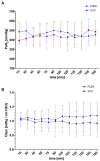Flow-controlled expiration reduces positive end-expiratory pressure requirement in dorsally recumbent, anesthetized horses
- PMID: 37124564
- PMCID: PMC10140341
- DOI: 10.3389/fvets.2023.1135452
Flow-controlled expiration reduces positive end-expiratory pressure requirement in dorsally recumbent, anesthetized horses
Abstract
Introduction: Equine peri-anesthetic mortality is higher than that for other commonly anesthetized veterinary species. Unique equine pulmonary pathophysiologic aspects are believed to contribute to this mortality due to impairment of gas exchange and subsequent hypoxemia. No consistently reliable solution for the treatment of peri-anesthetic gas exchange impairment is available. Flow-controlled expiration (FLEX) is a ventilatory mode that linearizes gas flow throughout the expiratory phase, reducing the rate of lung emptying and alveolar collapse. FLEX has been shown to improve gas exchange and pulmonary mechanics in anesthetized horses. This study further evaluated FLEX ventilation in anesthetized horses positioned in dorsal recumbency, hypothesizing that after alveolar recruitment, horses ventilated using FLEX would require a lower positive end-expiratory pressure (PEEP) to prevent alveolar closure than horses conventionally ventilated.
Methods: Twelve adult horses were used in this prospective, randomized study. Horses were assigned either to conventional volume-controlled ventilation (VCV) or to FLEX. Following induction of general anesthesia, horses were placed in dorsal recumbency mechanically ventilated for a total of approximately 6.5 hours. Thirty-minutes after starting ventilation with VCV or FLEX, a PEEP-titration alveolar recruitment maneuver was performed at the end of which the PEEP was reduced in decrements of 3 cmH2O until the alveolar closure pressure was determined. The PEEP was then increased to the previous level and maintained for additional three hours. During this time, the mean arterial blood pressure, pulmonary arterial pressure, central venous blood pressure, cardiac output (CO), dynamic respiratory system compliance and arterial blood gas values were measured.
Results: The alveolar closure pressure was significantly lower (6.5 ± 1.2 vs 11.0 ± 1.5 cmH2O) and significantly less PEEP was required to prevent alveolar closure (9.5 ± 1.2 vs 14.0 ± 1.5 cmH2O) for horses ventilated using FLEX compared with VCV. The CO was significantly higher in the horses ventilated with FLEX (37.5 ± 4 vs 30 ± 6 l/min).
Discussion: We concluded that FLEX ventilation was associated with a lower PEEP requirement due to a more homogenous distribution of ventilation in the lungs during expiration. This lower PEEP requirement led to more stable and improved cardiovascular conditions in horses ventilated with FLEX.
Keywords: anesthesia; atelectasis; equine; flow-controlled expiration; hypoxemia; positive end-expiratory pressure; respiratory; ventilation.
Copyright © 2023 Brandly, Midon, Douglas and Hopster.
Conflict of interest statement
The authors declare that the research was conducted in the absence of any commercial or financial relationships that could be construed as a potential conflict of interest.
Figures


Similar articles
-
Flow-controlled expiration improves respiratory mechanics, ventilation, and gas exchange in anesthetized horses.Am J Vet Res. 2022 Feb 16;83(5):393-398. doi: 10.2460/ajvr.21.10.0158. Am J Vet Res. 2022. PMID: 35175934
-
Effects of positive end-expiratory pressure titration on gas exchange, respiratory mechanics and hemodynamics in anesthetized horses.Vet Anaesth Analg. 2013 Nov;40(6):564-72. doi: 10.1111/vaa.12068. Epub 2013 Jul 15. Vet Anaesth Analg. 2013. PMID: 23848843
-
Flow-controlled expiration ventilation using a piston ventilator: effects of expiration time and speed on respiratory and pulmonary mechanics with focus on hysteresis and compliance in healthy horses.Am J Vet Res. 2024 Jun 5;85(8):ajvr.24.02.0036. doi: 10.2460/ajvr.24.02.0036. Print 2024 Aug 1. Am J Vet Res. 2024. PMID: 38901463
-
Causes, Effects and Methods of Monitoring Gas Exchange Disturbances during Equine General Anaesthesia.Animals (Basel). 2021 Jul 9;11(7):2049. doi: 10.3390/ani11072049. Animals (Basel). 2021. PMID: 34359177 Free PMC article. Review.
-
The evolution of anesthesia management of patients with anterior mediastinal mass.Mediastinum. 2023 Mar 6;7:16. doi: 10.21037/med-22-37. eCollection 2023. Mediastinum. 2023. PMID: 37261097 Free PMC article. Review.
Cited by
-
Cardiopulmonary effects of apneustic anesthesia ventilation in anesthetized pigs: a new mode of ventilation for anesthetized veterinary species.Front Vet Sci. 2024 May 24;11:1378617. doi: 10.3389/fvets.2024.1378617. eCollection 2024. Front Vet Sci. 2024. PMID: 38855412 Free PMC article.
-
Lung ultrasound score evaluation of the effect of pressure-controlled ventilation volume-guaranteed on patients undergoing laparoscopic-assisted radical gastrectomy.World J Gastrointest Surg. 2024 Jun 27;16(6):1717-1725. doi: 10.4240/wjgs.v16.i6.1717. World J Gastrointest Surg. 2024. PMID: 38983317 Free PMC article.
References
-
- Ruegg M, Bettschart-Wolfensberger R, Hartnack S, Junge HK, Theiss F, Ringer SK. Comparison of non-assisted versus head and tail rope-assisted recovery after emergency abdominal surgery in horses. Pferdeheilkunde. (2016) 32:469–78. doi: 10.21836/PEM20160508 - DOI
LinkOut - more resources
Full Text Sources

